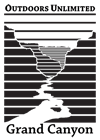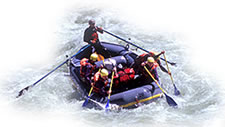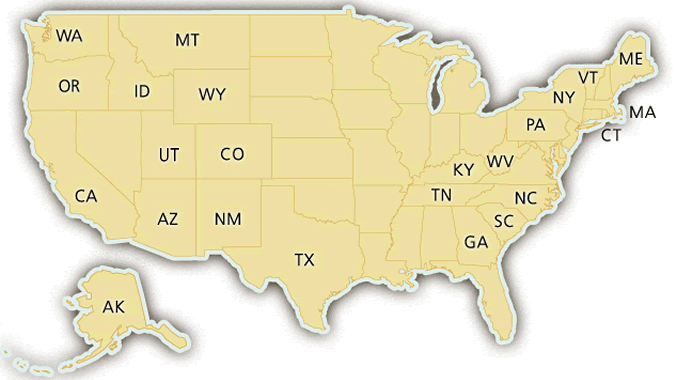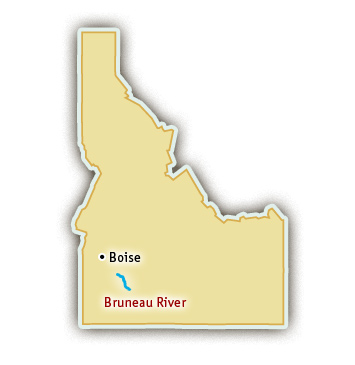Location: Breaks Interstate Park, Kentucky
Near the Breaks Interstate Park, on the border between Kentucky and Virginia, is a 1600 feet deep, five-mile long canyon of the Big Sandy River known as the Russel Fork. The Big Sandy River offers rafters some of the most challenging whitewater in the east.
Go Rafting with A Commercial Outfitter on the Big Sandy
Rafting.com is currently seeking qualified outfitters for Featured Listings. If you are a local rafting outfitter in Kentucky and would like to see your company listed here, please contact us for more information.>
Russell Fork of the Big Sandy: Class V+ / Advanced
Free-falling, steep-dropping, nail-biting rapids pile up one after another on the Russell Fork, the toughest commercially run stretch of whitewater in the eastern United States. The Russell Fork is so steep and tumultuous, it was considered Class VI unrunnable until the mid-90’s. Russell Fork river rafting trips are only for experienced Class IV and V rafters, since the river drops over 500 feet in a mere 2 1/2 miles. Within that 2 1/2 mile stretch there are six very technical Class IV-V+ rapids. Tower Falls, Twist and Turn, Triple Drop, El Horendo, the Maze, and Climax are one right after the other. Many of the rapids have several five to ten foot drops in a row just within the rapid. El Horendo, a steep waterfall-like drop, is the biggest commercially run “falls” in the United States. This pool-drop (drop, drop) style Russell Fork River rafting trip will thrill even the most adventurous adrenaline junkie.
Season: Four Weekends in October
Big Sandy River rafting trips take place four weekends each year in October, when scheduled releases from the Flannagan Dam on the Pound River flow into the Russell Fork of the Big Sandy. With the exception of the eight days in October, the Russell Fork itself is a free flowing stretch of river, meaning water levels are dependent on rainfall and flows are inconsistent. October is the nicest and most scenic time of year to go rafting in Kentucky due to the vibrant fall foliage and the cooling temperatures.
| Published July 2008 |
Location: Lexington, Kentucky
One mile shy of the official river classification length (100 miles), Elkhorn Creek, a tributary to the Kentucky River, is free-flowing, mellow, and scenic. Elkhorn Creek rafting is offered on a few stretches ranging from Class I-III that are suitable for families and children. Limestone bluffs rise 200 feet along the river, making the river canyon feel secluded and remote. Whitetail Deer and Rio Grande Wild Turkeys roam the area and make any Elkhorn Creek rafting trip a great wildlife experience for kids.
Go Rafting with A Commercial Outfitter on Elkhorn Creek
Rafting.com is currently seeking qualified outfitters for Featured Listings. If you are a local rafting outfitter in Kentucky and would like to see your company listed here, please contact us for more information.
Level of Difficulty: Class I-III / Beginner
Since Elkhorn Creek is 99 miles long, there are numerous options for rafting trips, however the most popular trip is on the Class II-III Gorge section, just 45 minutes from Lexington, Kentucky. The Gorge section begins just below the Jim Beam Distillery Dam. Elkhorn Creek rafting trips on the Gorge are a great way for families and youth groups to spend the day learning how to paddle and get comfortable running whitewater rapids before moving on to more difficult runs. Bring fishing poles because there is outstanding small mouth bass fishing on Elkhorn Creek as well.
Season: Mid-March – Labor Day
Rafting trips on Elkhorn Creek are available during the spring and summer through Labor Day weekend.
| Published July 2008 |
Location: Cumberland Falls State Park, Kentucky
The Cumberland River is one of the few whitewater runs in Kentucky that flows all summer, providing refreshing relief from the southern heat and humidity. The Cumberland River is dam controlled and the reliable flows allow for a long rafting season from May-September. There are outstanding accommodations including a comfortable lodge and dining facilities, as well as free wireless internet, in the Cumberland Falls State Resort Park. Cumberland River rafting trips are located halfway between Lexington, KY, and Knoxville, TN, and Atlanta is only 4 1/2 hours away.
Go Rafting with A Commercial Outfitter on the Cumberland River
Rafting.com is currently seeking qualified outfitters for Featured Listings. If you are a local rafting outfitter in Kentucky and would like to see your company listed here, please contact us for more information.
Level of Difficulty: Class III / Beginner
Just below the high and mighty Cumberland Falls, aptly named “The Niagra of the South,” is the put-in for Cumberland Falls whitewater rafting trips. Cumberland Falls is a 125-foot wide curtain of whitewater that pummels 60 feet into the Cumberland River. Rafters get a beautiful view of the falls at put-in before they paddle downstream into waves of whitewater. Cumberland River rafting trips are five miles long through Class III rapids such as Center Rock and Surfing Rapid. The Cumberland Falls rafting trip is ideal for families and beginning paddlers.
Season: May – September
The Cumberland River is one of the few rivers in Kentucky that flows all summer long.
| Published July 2008 |
In a state known for its Jim Beam whiskey and southern accents are three outstanding rivers for whitewater rafting. Kentucky whitewater rafting trips are located within a few hours from major urban areas such as Knoxville and Lexington and they are offered May through October.
Cumberland River Rafting Trips (Class II-III):
From May to September, Cumberland River rafting trips float through the Class II and III rapids on the Cumberland Falls run. Rafting on the Cumberland River is easily accessible from the Cumberland Falls State Resort Park, less than two hours from Lexington and Knoxville. Cumberland River trips are a good way to learn the sport of whitewater rafting.
Elkhorn Creek Rafting Trips (Class II-III):
The Class II-III Gorge section of Elkhorn Creek is a great beginner whitewater rafting trip. Just 45 minutes from Lexington, Elkhorn Creek rafting trips are easy to access, have fun rapids, and are suitable for the whole family.
Big Sandy River Rafting Trips (Class V+):
The Russell Fork of the Big Sandy River is one of the most daredevil commercially run stretches of whitewater in the United States. With multiple Class V+ drops and rapids that look more like waterfalls, Russell Fork rafting trips require previous Class IV experience.
Go Rafting with A Commercial Outfitter in Kentucky
Rafting.com is currently seeking qualified outfitters for Featured Listings. If you are a local rafting outfitter in Kentucky and would like to see your company listed here, please contact us for more information.
More About Rafting in Kentucky
Most Kentucky whitewater rafting trips are one-day in length, but they range in difficulty level from mild float trips on Elkhorn Creek to some of the most challenging whitewater in the United States on the Russell Fork of the Big Sandy River. During the summer months, rafting is a cooler alternative to hiking and bike riding for visitors of one of Kentucky’s many State Park Resorts. In the fall, Kentucky whitewater rafting trips offer a great way to enjoy some solitude and see the spectacular autumn colors.
| Published July 2008 |
Location: Wrangell St. Elias National Park, Alaska
A rafting trip on the Copper River is a true expedition, typically lasting from one to two weeks, depending on the number of side hikes and helicopter sightseeing tours. The river cuts through both the Wrangell and the Chugach mountain ranges and picks up a huge volume of water as crystal streams and waterfalls pour into the silt-filled river on its 287 mile journey to the Pacific Ocean.
Go Rafting with A Commercial Outfitter in Alaska
Rafting.com is currently seeking qualified outfitters for Featured Listings. If you are a local rafting outfitter in Alaska and would like to see your company listed here, please contact us for more information.
Level of Difficulty: Class I-II / Beginner
The Copper River is not a whitewater run. Its Class I-II riffles offer a gentle way to relax and enjoy the unfolding scenery.
Wildlife and Scenery: Glaciers, Abundant Riverine Birds and Mammals
Nature lovers will enjoy the rich populations of riverine mammals frequently spied on Copper River rafting adventures. Beaver, otters and seals all live in the riparian environment. Birders will appreciate the Arctic Terns, high-flying eagles, and other waterfowl that fill the air of the Copper River’s valleys. Dramatic “calving” often takes place near glaciers as huge chunks of ice fall off the frozen faces of these dramatic features in the Alaskan wilderness.
Season: June – August
Trips take place during the long Alaskan summer and, weather permitting, the Northern Lights can sometimes be seen during the brief night.
| Published July 2008 |
Location: Grand Canyon, Arizona, from Glen Canyon Dam to Lee’s Ferry
An alternative option to a multi-day rafting trip through the Grand Canyon is a one-day float trip from Glen Canyon Dam to Lee’s Ferry. Visitors will get to experience the incredible colors of the Grand Canyon and learn about the natural, geological, and human history of the area.
Level of Difficulty: Class I / Beginner
The section of The Grand Canyon between Glen Canyon Dam and Lee’s Ferry is rated Class I, which is the perfect trip for families or visitors who are looking for a mellow way to see the Grand Canyon in one day. Trip options include a large, motorized pontoon boat or a smaller, oar-powered raft.
Scenery: Red Sandstone Cliffs, Native American petroglyphs, Glen Canyon Dam
The views and the colors are spectacular and the history is rich and fascinating. Guides in the Grand Canyon are knowledgeable about the Native American history, John Wesley Powell’s expeditions, and the riveting politics that surround the Colorado River water. One day is hardly enough to learn all the interesting facets of the Grand Canyon, but a float trip through this section will give you a taste of the canyon that has captured many hearts and imaginations.
Season: March – November
The Colorado River through the Grand Canyon is dam-controlled and water is released year-round. Commercial trips typically run from March through November. During the summer, June – September, trips launch twice each day.
Tags: 1-Day, Class I, Family, Float, Group
| Published May 2008 |
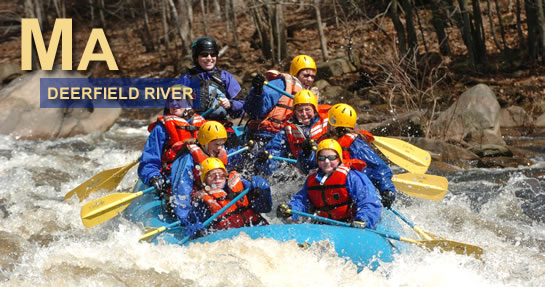
Location: Northwestern Massachusetts, near Boston
The Deerfield River originates in the Berkshire Mountains of Vermont and flows south into Massachusetts. Deerfield River rafting is available on two sections. The Zoar Gap run is perfect for beginners with Class II-III rapids while the Dryway is a more challenging Class IV section. This river is dam controlled and each section has a set schedule of release dates.
Go Rafting with A Commercial Outfitter on the Deerfield River
 Zoar Outdoor– Offering a wide range of outdoor activities, Zoar Outdoor has been a leader in the industry since 1989. Zoar Outdoor promotes self-propelled, low-impact, wilderness recreation in the Northeast. Zoar offers whitewater rafting trips on the Deerfield and West Rivers.
Zoar Outdoor– Offering a wide range of outdoor activities, Zoar Outdoor has been a leader in the industry since 1989. Zoar Outdoor promotes self-propelled, low-impact, wilderness recreation in the Northeast. Zoar offers whitewater rafting trips on the Deerfield and West Rivers.
Visit their website for more information about Deerfield River Rafting.
Zoar Gap: Class II-III / Beginner
The Zoar Gap run is the perfect rafting trip for beginners and larger groups. This section of river provides fun Class II and III rapids in a spectacular wilderness canyon. The Zoar Gap section is ten miles in length and starts off with some warm up rapids like Microwave, Freight Train and Pinball. In Zoar Gap, the canyon narrows into a technical boulder garden. Once you have completed the Zoar Gap, there are plenty of opportunities to jump into the water and float past the forested shoreline.
The history of this stretch is closely linked to the development of the railroad and hydropower. Environmentally, this section is important for the variety of bird species including red tail hawks, ospreys, bald eagles, and blue herons, its active beavers, and its potential as a trout fishery.
The Dryway: Class IV / Intermediate
The Dryway section of the Deerfield River offers challenging rapids in a remote setting. The rugged northern Berkshire Mountains provide the backdrop for this exceptional stretch of river. The Dryway run is about 3.5 miles long with Class III-IV rapids the whole way. From Factory Rapid past the Dunbar Brook Rapid to Labyrinth, the Class IV whitewater keeps your adrenaline flowing.
Season: May – October, Specified Release Dates
The Deerfield River is dam-controlled, so it is only raftable on scheduled dates when around 1000 cfs (cubic feet per second) is released from the dam. The Zoar Gap run is the most popular section of the Deerfield because it has the most reliable water, with more than one-hundred release days in the spring and summer. The Dryway Section has thirty-two release dates between May and October.
Tags: 1-Day, Beginner, Class II, Class III, Class IV, Group, Half-Day, Intermediate
| Published April 2008 |
The most popular place for Montana whitewater rafting trips is the Flathead River on the western edge of Glacier National Park. The terrain is wild and rugged but the whitewater rafting is friendly with something for just about everyone whether you’re a beginner or seasoned whitewater veteran.
- Flathead River Rafting Trips (Class III):
Flathead River rafting trips are offered on both the North Fork and Middle Fork of the Flathead River. The level of difficulty ranges from Class I floats to Class III+ whitewater adventures. The forks of the Flathead River form the western and southern boundaries of Glacier National Park so you are guaranteed spectacular wildlife viewing and awe inspiring scenery… not to mention great whitewater rafting.
Go Rafting with A Commercial Outfitter in Montana
Rafting.com is currently seeking qualified outfitters for Featured Listings. If you are a local rafting outfitter in Montana and would like to see your company listed here, please contact us for more information.
About Rafting in Montana:
During the last ice age, glaciers shaped the region by carving out “U” shaped valleys between parallel mountain ridges. Through these lush river valleys flow the Forks of the Flathead River. Today the majority of the Flathead is protected by the National Wild & Scenic Rivers Act and the Bob Marshall and Great Bear Wilderness Areas. Montana whitewater rafting trips are usually available from late-spring through the end of summer. You can choose a half, one, two or three day Montana whitewater rafting trip. You might even consider planning some extra time to do some hiking or backpacking in Glacier National Park.
| Published April 2008 |
Location: Southwestern Idaho
The Bruneau River is considered one of the most beautiful desert river canyons. Trips can be combined with the more challenging Jarbridge River for a longer wilderness experience. Rafting trips on the Bruneau River are 3-5 days, depending if they begin on the Jarbridge River or the Bruneau itself.
Level of Difficulty: Class III-IV / Intermediate
River trips last four days with beginner to intermediate Class III-IV rapids. While the rapids of the Bruneau are challenging, the weather can be even more exciting, bringing both sun and snow in the same day during its May through mid-June season.
The Canyon: Red Rock and Turquoise Waters
Bruneau River rafting is the West’s best-kept secret with a canyon unique to this continent. Some refer to it as the “Sistine Chapel” of all river canyons. The turquoise waters of the Bruneau River run for 40 miles through a tall canyon of red rock reminiscent of Bryce and Zion National Parks.
Scenery and Hiking
The steep and narrow character of the Bruneau River canyon provides a lot of shade for the riverside below, creating a lush riparian environment uncharacteristic of a desert river. In fact, the canyon is a safe haven for three endangered plant species. In May, wildflowers bloom and songbirds abound– more than 60 bird species call the Bruneau River home. Side hike opportunities are also numerous with one leading to Cave Creek where Native Americans once settled.
Season: May – Mid-June
The Bruneau River and the Jarbridge River are free-flowing, so the rafting season is dictated by the snow-melt and precipitation. Trips are run in the spring from May through the middle of June.
| Published March 2008 |


